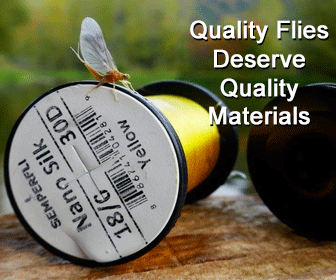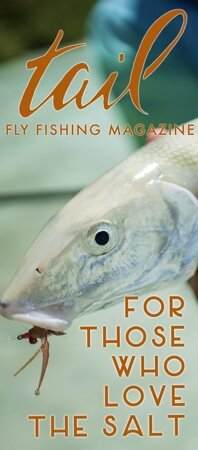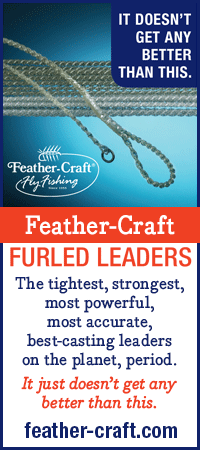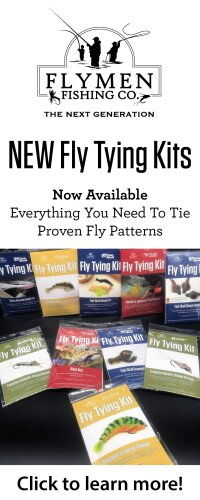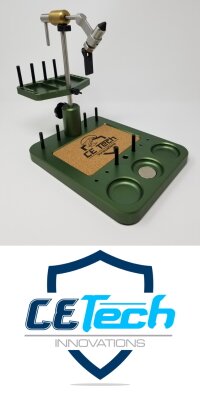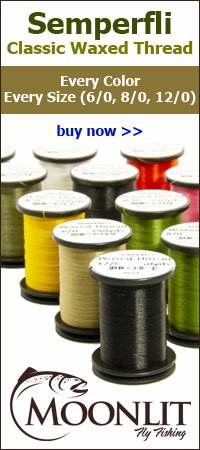How did you become interested in fly tying?
I have been a keen angler from the age of six, starting with a few lessons from my grandfather but pretty soon striking it out on my own as we did not live real close to my grandparents. My fishing was with floats, and ground bait, before moving onto spinning hardware and some such, or live bait for pike and zander.
My interest for flyfishing and flytying grew with the reading of books and magazines, such as Flyfisherman and Fly Rod & Reel. At the time flyfishing was not that common in the Netherlands, so in looking around how to get some lessons I joined the Casting Club of Amsterdam age 18, and started tying my flies at the same time.
Did you have a mentor when learning to tie?
Not really a mentor – though one experienced tier in the club provided some initial instruction and showed me how to tie a few basic patterns to get me started. My information came to me via books, mostly in the English language, and some magazines and the many, many catalogs I threw myself into. I was, and still am, a ferocious reader and I soaked up the information like a parched desert soaks up the rain when it decides to come visiting.
How does fishing and fly tying in the Netherlands differ from fishing or fly tying in the United States?
The Netherlands is a country without gradient. I happen to be a stream addict. Hmmmm…. what is wrong with this picture?
There is an abundance of surface water in the Netherlands, and there are many options to (fly)fish – though not for salmonids. The flyfishing is for what the British have termed “coarse fish” – such as pike, zander, perch, roach, bream, chub, ide and a more recent arrival from eastern Europe, the predatory asp.
For my stream fishing I travel into other parts of Europe (Germany, Denmark, the British Isles, Ireland, Slovenia, Bosnia, Croatia) – and indeed further afield to North America or New Zealand.
What do you like about using Cul De Canard feathers? I notice you use it quite often in your patterns. When selecting quality Cul De Canard feathers, what should one look for?
CDC is a very useful material for a number of the patterns I tie and fish. Just as any other material it has its strengths and weaknesses. What I try to do in my patterns is to draw on its strengths and compensate for weaknesses – either by selective techniques or in combination with other materials.
Some years back I wrote an in-depth article on CDC, the material and the usage, which was published by Flyfisherman magazine. An on-line copy can be found here:
http://globalflyfisher.com/
Would you rather use natural materials in your flies instead of using synthetics? If so, why?
I am first and foremost a trout and grayling angler, and most of my patterns reflect this – though of course I do branch out and tie pretty much every category in the known universe.
While I am certainly not dogmatic in this, for most of my tying I tend to prefer, and rely on, natural materials. Feathers are hard to replicate in man-made materials in any case, but natural hair (guard hair or underfur) offers a myriad of textures often in a mix of coarse and fine and different shades, and staple lengths. Nature has very few solid colors, and many subtle shifts can be seen when observing the natural materials up close.
I do use some synthetics in my trout and grayling patterns, but when I do this is almost always in combination with natural materials. I will reach for man-made materials to provide me with qualities I cannot fine in natural materials, be it textures (tinsels, flash), or specific uses such as tying saltwater patterns where many man-made materials come into their own.
Besides your staple pattern, CDC & Elk, is there another fly you have a lot of confidence in?
If I have to pick a single pattern to complement the CDC&Elk this would be its sibling, the Diving CDC&Elk. They are effective fished single, but at times fishing them in combination they redefine “lethal”.
If you had a small fly box that only held 10 flies of any kind. What flies would you fill it with to go trout fishing?
This is in fact how I do my freshwater trout and grayling fishing (I have been known to fish for days out of a single tiny Tiemco hook box, crammed full of CDC&Elk and a couple nymphs 😉 ) – drawing from a small number of mostly generic patterns.
This K.I.S.S. approach has served me well across several decades and many bodies of water across three continents.
My staple set holds:
CDC&Elk – see video
Bruce Salzburg’s Crippled CDC&Elk – see video
Bob Wyatt’s DHE 2.0 – see video
Diving CDC&Elk – see video
Z-Dun – see video
Frank Sawyer’s Pheasant Tail nymph – see video
A rather generic GRHE nymph – Gold Ribbed Hare’s Ear – see video
Jack Gartside’s Sparrow – see video
Jaap van der Heijden’s Jacobpattern – see video
A generic Woolly Bugger – see video
Could you tell us about your website, Flytier’s Page?
I set up Flytier’s Page (flytierspage.com) to provide a gallery by and for flytiers the world over. It has a very focused aim – to provide a platform for flytiers around the world to present a set of flies they like to be identified for. In order to deliver a consistent quality of images I do all the fly photography.
From its humble beginnings in 1997 it has grown to be a serious collection of patterns, submitted by several hundred tiers.
Flytier’s Page has been recently expanded to also provide a substantial list of my video flytying tutorials.
How would you describe a Flymph?
As the word Flymph was coined by Pete Hidy, I will defer to him for the definition:
“A wingless wet fly with a soft, translucent body of fur or wool which blends with the undercolor of the tying silk when wet, utilizing soft hackle fibers easily activated by the currents to give the effect of an insect alive in the water, and strategically cast upstream or across for the trout to take just below or within a few inches of the surface film.”
(Hans shows how to tie a Flymph in this video.)
In your opinion, what defines a good fly tier?
Now there’s a simple question… without a simple, unambiguous answer ;-)For me a good flytier is comfortable tying the breadth of patterns with competence, and is in control over the materials.He or she is a person with a sound understanding of techniques, properties of materials, their uses/strengths/weaknesses. He or she has a historical perspective, appreciation and respect, yet approaches novel techniques and materials with an open mind. Keen to push the boundaries of his or her tying, to improve with each fly tied.
Do you fish with small flies often? Flies that are sizes ranging from #18 to #28?
I would not consider #18 a small fly, though of course #28 does qualify 😉
Do you feel there is any advantage in using really small flies?
I generally explain it like this – while I quite enjoy tying very small patterns, I do not particularly enjoy fishing them – but when you need to, you NEED to!
When you design a new fly pattern, are their specific steps you follow?
There is no set sequence, but here are two common scenarios:
1. I ‘see’ a pattern in my head, and then apply materials to a hook to produce a tangible replica. Then test and fine-tune as needed.
2. I look at, and handle, specific materials, ‘see’ a promising use for it or them – and a pattern comes from it.
I very rarely do patterns to imitate a specific insect – my patterns are invariably of a generic, impressionistic nature.
What fly tying vise do you use?
I have worked my way through a number of tying vises until a friend, Lawrence Waldron, made me ‘my’ perfect vise in 1989 – this model vise has become known as the LAW Bench vise. Now well into its third decade of use, and I am loving every minute tying on it.
Even though you have been tying for many years, are there any things that you have learned or discovered recently that have made your tying better or easier?
There are, actually. For the past ten or so years I have been using ever more the split thread technique in a range of pattern styles, using a range of natural and synthetic materials, be they fur, feather barbs or loose dubbing. The split thread technique is really cool, really useful, and should be in every tier’s toolkit.
Have you been working on a new fly pattern or video recently?
*chuckle* all the time – both areas.
I am quite enjoying doing the tying videos – I think tying videos are the next best thing to getting one on one instruction, and in some ways provide a superior view into the subtleties of material manipulation and techniques.
My channel on Youtube (hansweilenmann) has, at this time of writing, some 130-odd HD resolution videos, and many more in the pipeline. The same set can be viewed via Flytier’s Page
Do you have any advice for less experienced fly tiers out there?
– Every tier starts out knowing nothing, and then builds out from there. You are not alone in this. Start absorbing.
– Lay a solid foundation by mastering the basic techniques, and build on them.
– Sound techniques enables you to build well proportioned, durable, effective working flies – techniques count for way more than fancy tools or expensive materials.
– Make it a priority to be the master over your materials, lest it becomes the master over you.
– Each fly ever tied has room for improvement, see this as a challenge and an opportunity.
– Practice does _not_ make perfect – only perfect practice does. (Otherwise you just get very skilled at making the same mistakes 😉 )
– Be fearless, be critical, keep an open mind and learn every day, and above all have fun!.
Do you have anything at all to add?
We live in the Golden Age of flytying. Never before, in the history of our sport, has the availability of materials been better, but more than that, the availability and real-time nature of information on techniques, materials and patterns has made, and will continue to make, this the finest time to be a flytier and flyfisherman.
- Bog Fly Variant
- CdL & Silver Wet
- CfR (Casting for Recovery)
- Clarice
- Flavio
- Hatching Olive Variant
- Iron Blue Dun
- Puterbaugh Caddis Variant
- Simple Nymph
- Sliver
- Sunshine & Shadow
- Z-dun LDO (Large Dark Olive)





































